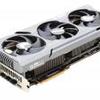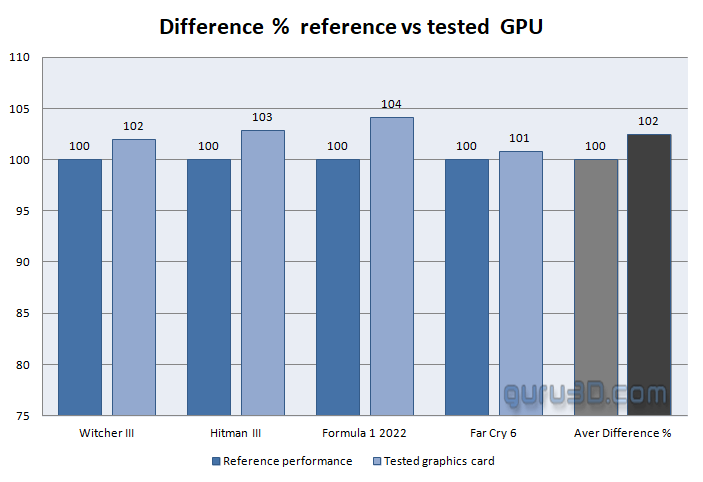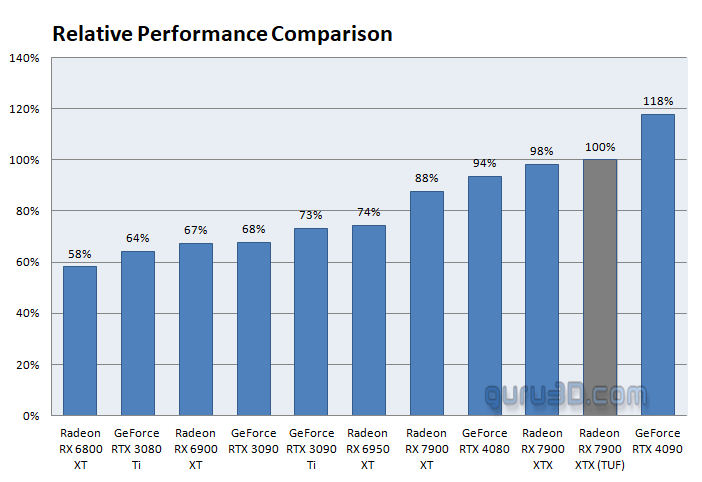Final words and conclusion
Final words
ASUS hit the nail on the head with the TUF; it has the most excellent acoustics we have tried with an XTX and keeps its cool while running under load. We think the OC model is understated compared to its rivals, as the additional performance is merely 2~3% at best. The final result is a proper-looking, excellent-performing product. I do seem to like the XTX much better than the XT. It's hard to explain why that to a 10~15% performance e differential can make so much of a perceptible difference, though. The Radeon RX 7900 XTX. It positions itself in that RTX 4080 marker of performer better, for 100 USD more than the regular 7900 XT model. The flagship GPU of AMD's rDNA3 is adequately competitive with NVIDIA's 4080 and often even 4090. When looking at raw shader performance, it's plenty fast ... often passing the more expensive GeForce RTX 4080. The Radeon RX 7900 Series has two Achilles' heels.
First, AMD relies extensively (possibly excessively) on the extra L3 cache (infinity cache); caching does assist tremendously, but mainly for CPU/fillrate/driver-constrained scenarios and not so much high resolutions like UHD at 3840x2160. Consequently, AMD performs exceptionally well at resolutions up to 2560x1440; however, in Ultra HD, where brute raw horsepower is required, the dynamic can change quickly. The second Achilles heel is Raytyracing performance. Here AMD is still not at the same performance level as NVIDIA, as they are making bigger steps with each generational update, albeit with the XTX; it's not bad, though and certainly much better than the XT. Combining these two facts drags down UHD performance in very specific render workloads; however, it indeed isn't drowning. Now that we have established these points, we need to position the card, and here AMD wins; frame for frame rendered, AMD has a cheaper (yeah, I said cheaper, not cheap) solution. AMD's Raytracing performance can be assisted and thus improved using technologies like FSR2. In many scenarios, this card competes with the 4080, which is a very good place to be in for $999. In lower than UHD resolutions, it can even keep up with the 4090 thanks to the excessive L3 cache. This product significantly outperforms the previous 6900 series in terms of raw shader performance. The cost of all this fun is $999, and yeah, that is the starting price for solely the reference model. Graphics cards have entered a pricing zone that most consumers can no longer afford. PC gaming has grown increasingly pricey, prompting players to seek other solutions. However, we are pleased with the performance we observed overall.
Performance
You've seen the numbers, and we've already let the cat out of the bag. It all comes down to gaming performance and, of course, rendering quality. The RX 7900 XTX provides more value for the money than seen from the 4080, as we're getting close to raw performance levels that easily enable gaming at 4K resolution. Most enthusiast gamers play at UWHD, QHD, or UHD monitor resolutions. This card is designed for precisely that kind of gamer.
The old rasterizer engine breaks right through the previous limit of extreme performance. Realistically the 7900 XTX often sits at the performance level of a 4080. This chart is based on raw shader engine performance; when NVIDIA flicks on Raytracing and DLSS3 with its frame generator, AMD will be left behind, even with FSR2. However, in general, we're happy with what we're seeing performance-wise for the XTX. The ASUS TUF OC model brings in another 2-3%.
Cooling & noise levels
Acoustics-wise, the card initially cannot be heard as long as you stick to the silent mode BIOS, which we recommend. The performance mode BIOS after a while, breaches a more moderate 38 DBa. Considering that the silent mode runs your games as fast as performance mode, and the card remains under 65 degrees C, why even bother with performance BIOS mode? FLIR imaging doesn't show anything scary. Also, keep in mind that if you go for a custom card from a board partner, the power consumption levels will likely be higher due to increased TGPs and stuff like RGB and liquid cooling pumps.
Energy
Remember that the Radeon RX 7900 XTX is a high-end gaming product that still uses much power. Under full load, the card uses about 377 Watts (average). This Wattage is directly related to how much heat the GPU, which sits inside a closed case, gives off. That, by the way, is a lot, but we do need to acknowledge that the RX 7900XTX is relatively efficient with that power budget.
Coil whine
Any card will exhibit a notch of coil whine once it reaches a high FPS. Is it annoying? It's at a level you can hear it when you hit highly high framerates. In a closed chassis, that noise would fade away in the background. However, you can hear the coil whine/squeal with an open chassis. Graphics cards all make this in some sort or form, especially at high framerates this can be perceived. It's as good as it can get, and we have not been bothered by it.
Pricing
The reference edition costs USD 999, which is a lot of money still for something that can be used to play PC games. It's a more appealing offer compared to the RTX 4080 and 4090 if that MSRP holds ground, and herein, we have a lot of doubt. indications are that only a low volume of these cards will be available at launch. Most likely, AIB cards will cost even more. Now, I can say all kinds of rude things about prices, but these products will still sell no matter what I say. We expect that this model sells at an MSRP 1149~1199 USD.
Tweaking
The card tweaks well; on the unlocked BIOS, you, however, get even more TGP available. The power limiter (allowed wattage) at +15% helps out, so that's your first and quickest option to tweak. You get extra perf on the card's default power budget. The boost clock frequency can take a suitable 2950-3000 MHz (frequencies vary per game title as they are dynamic). The memory could be tweaked to ~21.5 Gbps, so all these accumulated values brought ~8% additional performance on challenging GPU situations, measured from reference performance.
Conclusion
The TUF Gaming OC edition is a powerhouse in terms of gaming performance, it runs cool and optionally very silent however will require some serious real estate in your PC chassis as well as your wallet. The XTX is a serious step up in terms of overall performance and features; at UHD, it is struggling to compete with NVIDIA's flagship product, the GeForce RTX 4090. Realistically that differential is roughly 20%. So as long as the price is reasonable, that is acceptable and yeah, at 1099-1149 USD for the model as tested, it remains that reasonable. Thanks to the infinity cache, it's sometimes even passing that 4090; however, that applies to lower resolutions, fillrate and CPU-bound situations. The actual performance for a card of this calibre needs to be sought in the UHD performance domain, and there it's sometimes lacking a little. It's still highly competitive with the RTX 4080 and, add to that, less expensive than the RTX 4080. The series 7900 XTX products will provide suitable Ultra HD performance at a more affordable price and be an excellent energy-efficient product while at it. Pure Raytracing performance is a notch slower than the competition; however, you can make up a lot of performance if that game supports FSR. But likewise, NVIDIA can apply DLSS3. Price-wise, this card offers good value over the RTX 4080, which starts at $1199. Since there will be so few 7900 XTX units available at the first launch wave, we highly doubt you will be able to buy one at MSRP. Prices in the EU will be well beyond 1250 EUR. This purebred stallion has high energy requirements and serves a limited clientele. Is it a good idea to buy this item? The price tag is a bit much, and you would be better off waiting for the next GeForce RTX 4070 or 7800. In conclusion, ASUS nailed it with the new TUF Gaming OC in design and features; nevertheless, the default extra performance for this factory-tweaked model is only 2, maybe 3%; ergo, go for the cheaper non-OC model, we say. If you are truly into silent operation and amazing design, we can recommend this card over the reference model (at a price premium).
- Download AMD Radeon drivers
- Sign up to receive a notification when we publish a new article.
- Or go back to Guru3D's front page
- Hilbert, LOAD"*",8,1.




